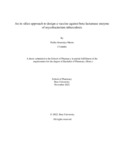An in-silico approach to design a vaccine against beta lactamase enzyme of mycobacterium tuberculosis

View/Open
Date
2022-11Publisher
Brac UniversityAuthor
Meem, Fatiha SoumaiyaMetadata
Show full item recordAbstract
More people die from tuberculosis (TB) than any other disease worldwide, which happens due to the presence of drug-resistant forms of Mycobacterium tuberculosis (Mtb). A vaccination against the beta lactamase enzyme of Mycobacterium TB has been developed in this study using cutting-edge computational tools and methods. Using the UniProt Knowledgebase (UniProtKB), the appropriate bacterial enzyme was chosen. Applying the Vaxijen v2.0 platform, antigenicity was anticipated. NetCTL 1.2 server was employed in order to determine the cytotoxic T lymphocytes (CTL). The MHC I alleles specific to CTL were also predicted through NetMHC Pan 4.1 server. The helper T lymphocytes (HTL) were found out with the help of the NetMHC II pan 4.0 tool. Using IFN epitope servers, IL4 pred servers, and IL10 pred servers, respectively, the productivity of interferon gamma, IL4, and IL10 of the CTL and the HTL were anticipated. Prediction of epitopes for B cells were done by employing Bepipred linear epitope prediction model 2.0. Considering their toxicity, antigenicity, and allergenicity, the B and T cells underwent additional testing. Linkers were inserted in between the adjuvant and epitopes for B and T cells to create the vaccine. To forecast the vaccine's allergenicity, antigenicity, toxicity, and other physiochemical features, various bioinformatics approaches were employed. The PROTPARAM server was used
to perform biochemical analysis of the proposed vaccination. Phyre2 was utilized in order to
validate the 3D structure of vaccine candidate. Patchdock tool was used to perform the docking between the obtained 3D structure with toll-like-receptor (TLR-3). To perform the Ramachandran plotting and Z scores analysis Swiss PDP plotter and Prosaweb servers were used respectively. Lastly, the immune simulations were carried out utilizing C-Immsim.
